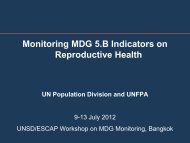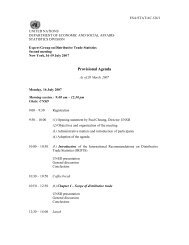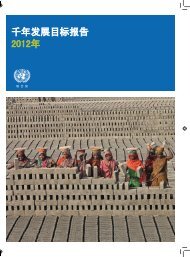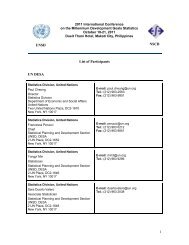demographic yearbook annuaire demographique 1951
demographic yearbook annuaire demographique 1951
demographic yearbook annuaire demographique 1951
You also want an ePaper? Increase the reach of your titles
YUMPU automatically turns print PDFs into web optimized ePapers that Google loves.
These regulations are as binding on each member government<br />
ofthe World Health Organization as any international<br />
treaty or convention unless a note of rejection or reservation<br />
is formally transmitted to the World Health Organization<br />
within a specified time period. The provisions of Nomendature<br />
Regulations No.1 came into force on 1 January<br />
1950. It is therefore expected that, for the next decade,<br />
countries will publish statistics on causes of death classified<br />
according to the Sixth Revision, beginning with data for<br />
the calendar year 1950.<br />
Principles of classification<br />
The International Lists of Causes of Death have followed<br />
the basic principles laid down by Dr. William Farr and<br />
summarized in his statement that: "The primary divisions<br />
of a Statistical Nosology should evidently be founded upon<br />
the mode in which diseases affect the population; whether<br />
they are generated and prevail only in particular localities<br />
(endemics), extend like cholera over nations (epidemics),<br />
or are propagated by contagion; whether they arise in an<br />
isolated manner (sporadically) from ordinary causes, and<br />
sources existing in the organization itself; or whether they<br />
are caused by violent means". 3 Because neither medical<br />
science nor registration practice had succeeded in producing<br />
clear-cut criteria for characterizing many of the diseases of<br />
the organs and systems of the body, Farr proposed that these<br />
"sporadic diseases" be grouped according to the anatomic<br />
systems affected. Thus, his classification gave five broad<br />
categories: (1) epidemic diseases; (2) constitutional (general)<br />
diseases; (3) local diseases, according to anatomical site;<br />
(4) developmental diseases; and (5) deaths from violence.<br />
Although this classification was not adopted when first proposed,<br />
the general arrangement has been followed throughout<br />
the various revisions of the International List of Causes<br />
of Death.<br />
Farr further proposed that the principles quoted below<br />
should be followed in determining what diseases or conditions<br />
should be specified as separate categories within the<br />
five broad groups.<br />
1. "Diseases distinctly specified in the returns, although<br />
not offrequent occurrence, like diabetes, have each a<br />
place in the tabular form; so that the facts thus fully<br />
laid before the public may be separately compared,<br />
and classified in any way likely to lead to useful<br />
results. Where a particular disease occurred very<br />
rarely, it was classed under a general head and<br />
referred to in notes."<br />
2. "The number of groups has, however, been diminished,<br />
because no general principles can be deduced<br />
from small numbers, accidental irregularities destroying<br />
the results, according to the well known<br />
doctrine of probabilities. Besides it was useless to<br />
keep up distinct heads, which, although distinguished<br />
in some, were confounded in other returns.<br />
3. "When after whooping cough it was stated that the<br />
patient died of pneumonia, the case has been referred<br />
to the primary disease; and the same principle<br />
has been adhered to in similar instances." 4<br />
These principles also have been generally followed in the<br />
International Lists of Causes of Death. Specific categories<br />
are set up for the various diseases and conditions on the<br />
3 Humphreys, Noel A. (Editor), Vital Statistics. A Memorial Volume<br />
of Selections From the Reports and Writings of William Farr, Offices of the<br />
Sanitary Institute, London, 1885, page 232.<br />
4 Ibid, page 233.<br />
basis of frequency of occurrence, importance as a cause of<br />
death and the facility with which they lend themselves to<br />
characterization as separate disease entities. Separate categories<br />
are provided for diseases which can be readily differentiated<br />
but which are grouped together because of small<br />
frequencies. Other categories are provided for less well<br />
defined conditions, being composed of diseases which are<br />
closely related, but not identical. There are also residual<br />
categories for conditions that cannot be differentiated sufficiently<br />
to warrant the creation of separate rubrics. Since the<br />
primary purpose is to provide a basis for compiling statistics,<br />
not every condition or diagnosis is shown as a separate category,<br />
as would be the case in a medical nomenclature.<br />
However, there are provisions for the proper statistical classification<br />
of every medical term that may be reported.<br />
Each succeeding revision of the International List of<br />
Causes ofDeath has reflected the advances in medical science<br />
by the inclusion of categories for new disease entities. Also,<br />
more and more emphasis has been given to the etiology of<br />
disease. However, it has not been found practicable or<br />
desirable to shift the classification completely to an etiological<br />
base. Such a shift would result in the separation of<br />
allied diseases, or the breaking up of meaningful disease<br />
entities into many fragmentary etiological components which<br />
would not have much significance from the statistical point<br />
of view.<br />
Fifth (1938) Revision<br />
The Sixth (1948) Revision has not been in force long<br />
enough for statistics utilizing the new classification to be<br />
generally available. Consequently, the data presented in<br />
this volume are based on the Fifth (1938) Revision of the<br />
International List which became effective in many of the<br />
signatory nations early in the 1940-1949 decade. This list<br />
is composed of 18 major groups sub-divided into 200 numbered<br />
titles. Many of these numbered rubrics are further<br />
divided into subtitles designated by letters (a, b, c, etc.)."<br />
In addition to the detailed list of 200 titles, an intermediate<br />
list of 87 titles and an abridged list of 44 titles were<br />
approved by the Fifth Revision Conference in 1938. (The<br />
statistics given in this volume are based on the abridged<br />
list). The intermediate list is a condensation of the detailed<br />
list and provides information concerning each of the 18<br />
major groupings of the detailed list. The abridged list is a<br />
further condensation in which a number of the 18 major<br />
groups have been combined. For the most part, this abridgement<br />
has not resulted in any important loss of specific information<br />
concerning the significant causes of death for international<br />
comparison.<br />
Although the intermediate and the abridged lists were<br />
designed to provide a convenient, uniform basis for the publication<br />
rather than the coding of national data for international<br />
comparison, a number of countries have also used<br />
one of these lists for coding purposes. This severely limits the<br />
availability of detailed information on causes of death needed<br />
for national use. However, in view of the quality of<br />
medical information usually obtained in these countries,<br />
these limitations do not appear to be particularly serious.<br />
Sixth (1948) Revision<br />
The Sixth (1948) Revision adopted for use by many<br />
nations starting in 1950 represents a rather sweeping change<br />
"L'Institut International de Statistique, Nomenclature Internationale<br />
des Causes de Dec""" 1938, La Haye 1940.<br />
19













